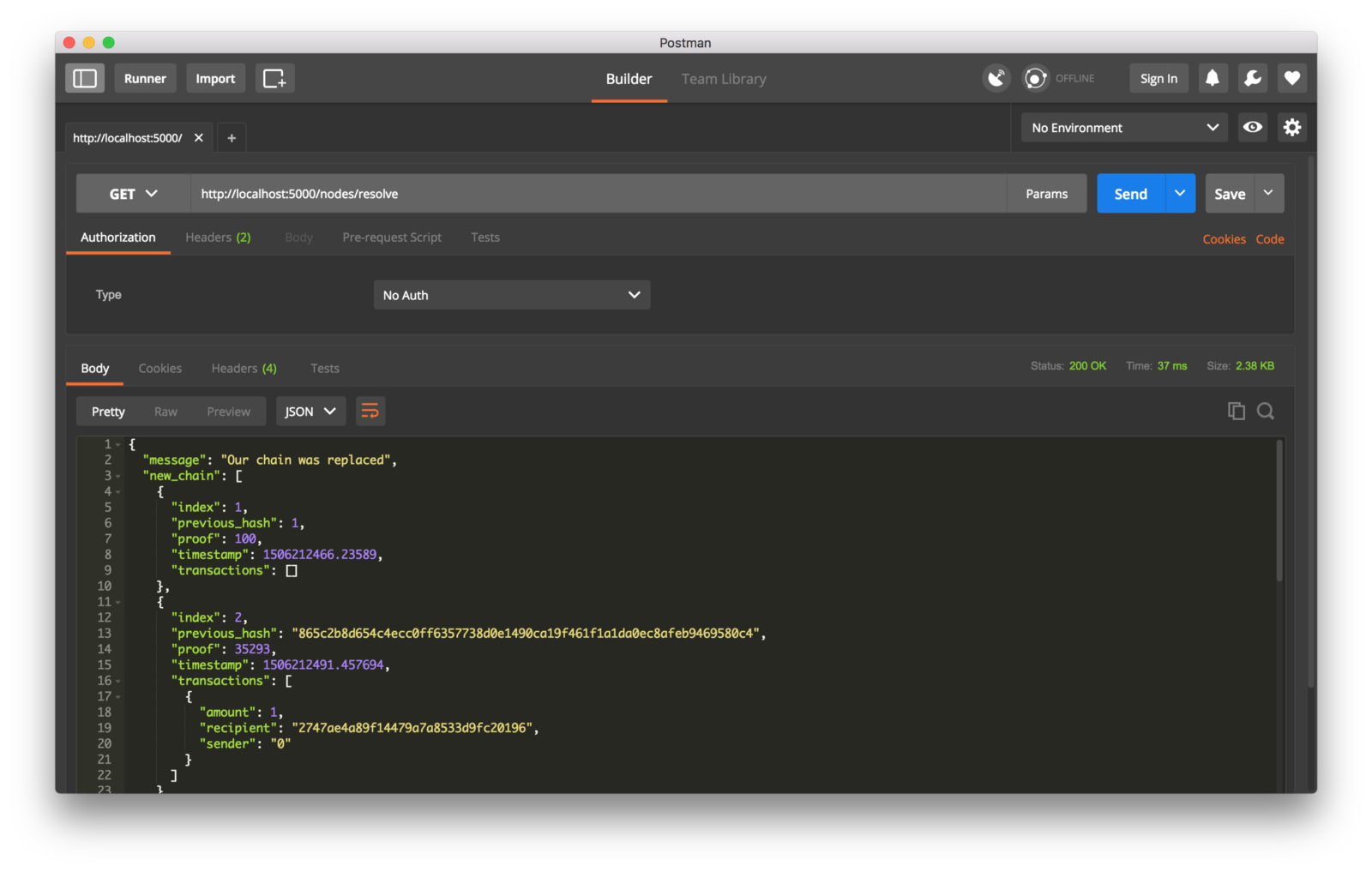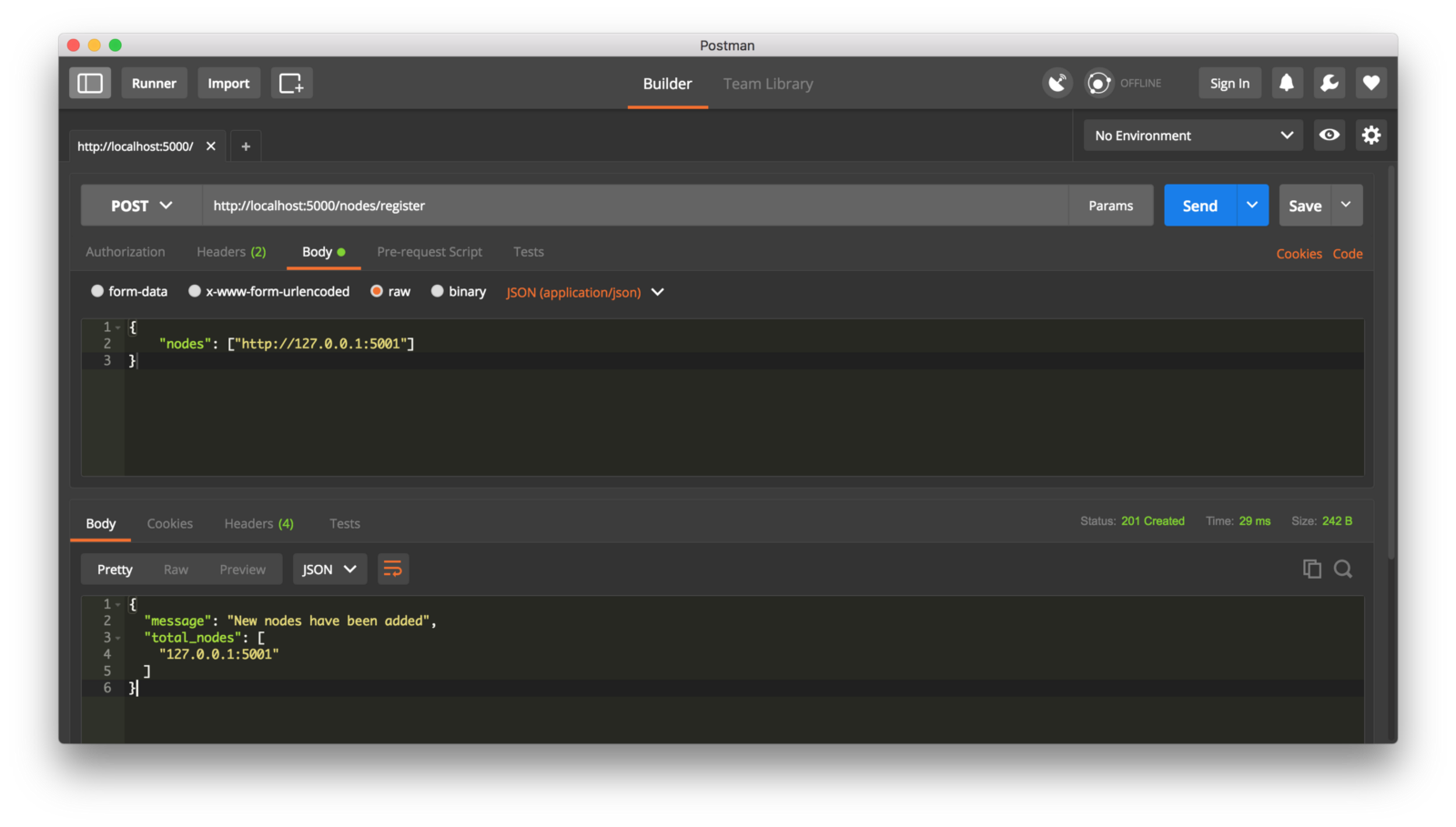看了很久的区块链知识点,在学习前编写过此篇博客的内容,现在再次编写一次,希望可以有更多的学习心得体会
环境准备
确保安装了Python3.6+,pip,Flask,Requests,如果在mac上python的环境是3.6+,安装Flask和Requests应使用pip3
pip3 install Flask==0.12.2 requests==2.18.4
与此同时还需要HTTTP客户端,比如Postman,cURL或其他客户端。本次实例中,使用的是postman。
构建BlockChain
Blockchain类
首先创建Blockchain类,在构造函数中创建了两个列表,一个用于存储区块链,一个用于存储交易。 以下是Blockchian类框架:
class Blockchain(object):
def __init__(self):
self.chain = []
self.current_transactions = []
def new_block(self):
# Creates a new Block and adds it to the chain
pass
def new_transaction(self):
# Adds a new transaction to the list of transactions
pass
@staticmethod
def hash(block):
# Hashes a Block
pass
@property
def last_block(self):
# Returns the last Block in the chain
pass
Blockchain类用来管理链条,它能存储交易,加入新块等。
块结构
每个区块包含属性:索引(index),Unix时间戳(timestamp),交易列表(transactions),工作量证明,上一个区块的Hash。下边是一个区块的结构:
block = {
'index': 1,
'timestamp': 1506057125.900785,
'transactions': [
{
'sender': "8527147fe1f5426f9dd545de4b27ee00",
'recipient': "a77f5cdfa2934df3954a5c7c7da5df1f",
'amount': 5,
}
],
'proof': 324984774000,
'previous_hash': "2cf24dba5fb0a30e26e83b2ac5b9e29e1b161e5c1fa7425e73043362938b9824"
}
通过区块Hash,保障区块链的不可变性,如果攻击者破坏前面的某个区块,那么后边的所有区块Hash都会变得不正确。
交易
添加一项交易,完善new_transaction方法
class Blockchain(object):
...
def new_transaction(self, sender, recipient, amount):
"""
生成新交易信息,信息将加入到下一个待挖的区块中
:param sender: <str> Address of the Sender
:param recipient: <str> Address of the Recipient
:param amount: <int> Amount
:return: <int> The index of the Block that will hold this transaction
"""
self.current_transactions.append({
'sender': sender,
'recipient': recipient,
'amount': amount,
})
return self.last_block['index'] + 1
通过向列表中添加交易,返回该记录被添加到区块,下一个待挖掘的区块的索引,等下在用户提交交易时会用。
创建新块
当把Blockchain实例话后,需要创造创世区块,并且加入工作量的证明。每个区块都需要经过工作量证明,俗称挖矿。完善new_block(),new_transaction()和hash()方法。
import hashlib
import json
from time import time
class Blockchain(object):
def __init__(self):
self.current_transactions = []
self.chain = []
# Create the genesis block
self.new_block(previous_hash=1, proof=100)
def new_block(self, proof, previous_hash=None):
"""
生成新块
:param proof: <int> The proof given by the Proof of Work algorithm
:param previous_hash: (Optional) <str> Hash of previous Block
:return: <dict> New Block
"""
block = {
'index': len(self.chain) + 1,
'timestamp': time(),
'transactions': self.current_transactions,
'proof': proof,
'previous_hash': previous_hash or self.hash(self.chain[-1]),
}
# Reset the current list of transactions
self.current_transactions = []
self.chain.append(block)
return block
def new_transaction(self, sender, recipient, amount):
"""
生成新交易信息,信息将加入到下一个待挖的区块中
:param sender: <str> Address of the Sender
:param recipient: <str> Address of the Recipient
:param amount: <int> Amount
:return: <int> The index of the Block that will hold this transaction
"""
self.current_transactions.append({
'sender': sender,
'recipient': recipient,
'amount': amount,
})
return self.last_block['index'] + 1
@property
def last_block(self):
return self.chain[-1]
@staticmethod
def hash(block):
"""
生成块的 SHA-256 hash值
:param block: <dict> Block
:return: <str>
"""
# We must make sure that the Dictionary is Ordered, or we'll have inconsistent hashes
block_string = json.dumps(block, sort_keys=True).encode()
return hashlib.sha256(block_string).hexdigest()
实现工作量证明
新区块依赖工作量证明算法(proof of work)构造。PoW的目标是找出一个符合特定条件的数字,这个数字很难计算,但容易验证。 实现一个较简单的pow算法,规则:寻找一个数p,使得他与前一个区块的proof拼接撑的字符串的Hash值为4个0开头。
import hashlib
import json
from time import time
from uuid import uuid4
class Blockchain(object):
...
def proof_of_work(self, last_proof):
"""
简单的工作量证明:
- 查找一个 p' 使得 hash(pp') 以4个0开头
- p 是上一个块的证明, p' 是当前的证明
:param last_proof: <int>
:return: <int>
"""
proof = 0
while self.valid_proof(last_proof, proof) is False:
proof += 1
return proof
@staticmethod
def valid_proof(last_proof, proof):
"""
验证证明: 是否hash(last_proof, proof)以4个0开头?
:param last_proof: <int> Previous Proof
:param proof: <int> Current Proof
:return: <bool> True if correct, False if not.
"""
guess = f'{last_proof}{proof}'.encode()
guess_hash = hashlib.sha256(guess).hexdigest()
return guess_hash[:4] == "0000"
算法复杂度通过修改0的个数。0个数越多,复杂度越大。
Blockchain作为API接口
使用python flask框架,一个轻量Web应用框架,它方便将网络请求映射到python函数,现在将Blockchain运行在基于Flask web上。 我们将创建三个接口:
- /transactions/new 创建一个交易并且添加到区块
- /mine 告诉服务器去挖掘新区块
- /chain 返回整个区块链
创建节点
添加框架代码:
import hashlib
import json
from textwrap import dedent
from time import time
from uuid import uuid4
from flask import Flask
class Blockchain(object):
...
# Instantiate our Node
app = Flask(__name__)
# Generate a globally unique address for this node
node_identifier = str(uuid4()).replace('-', '')
# Instantiate the Blockchain
blockchain = Blockchain()
@app.route('/mine', methods=['GET'])
def mine():
return "We'll mine a new Block"
@app.route('/transactions/new', methods=['POST'])
def new_transaction():
return "We'll add a new transaction"
@app.route('/chain', methods=['GET'])
def full_chain():
response = {
'chain': blockchain.chain,
'length': len(blockchain.chain),
}
return jsonify(response), 200
if __name__ == '__main__':
app.run(host='0.0.0.0', port=5000)
发送交易
发送的节点的交易数据结构如下:
{
"sender": "my address",
"recipient": "someone else's address",
"amount": 5
}
基于接口添加交易,代码如下:
import hashlib
import json
from textwrap import dedent
from time import time
from uuid import uuid4
from flask import Flask, jsonify, request
...
@app.route('/transactions/new', methods=['POST'])
def new_transaction():
values = request.get_json()
# Check that the required fields are in the POST'ed data
required = ['sender', 'recipient', 'amount']
if not all(k in values for k in required):
return 'Missing values', 400
# Create a new Transaction
index = blockchain.new_transaction(values['sender'], values['recipient'], values['amount'])
response = {'message': f'Transaction will be added to Block {index}'}
return jsonify(response), 201
挖矿
做三件事情:
- 计算工作量证明PoW
- 通过增加一个交易授予矿工(自己)一个币
- 构造新区块并将其添加到链中 ```Python import hashlib import json
from time import time from uuid import uuid4
from flask import Flask, jsonify, request
…
@app.route(‘/mine’, methods=[‘GET’]) def mine(): # We run the proof of work algorithm to get the next proof… last_block = blockchain.last_block last_proof = last_block[‘proof’] proof = blockchain.proof_of_work(last_proof)
# 给工作量证明的节点提供奖励.
# 发送者为 "0" 表明是新挖出的币
blockchain.new_transaction(
sender="0",
recipient=node_identifier,
amount=1,
)
# Forge the new Block by adding it to the chain
block = blockchain.new_block(proof)
response = {
'message': "New Block Forged",
'index': block['index'],
'transactions': block['transactions'],
'proof': block['proof'],
'previous_hash': block['previous_hash'],
}
return jsonify(response), 200
交易的接受者为服务器节点。
### 一致性(共识)
区块链系统是分布式的,既然是分布式的,那么我们究竟拿什么保证所有节点有同样的链,,如果网络上有许多节点,那么必须实现一致性算法。
### 注册节点
在实现一致性算法前,我们需要找到一种方式让一个节点知道其相邻节点。每个节点都需要保存一份包含网络中其他节点的记录。因此让我们新增几个接口:
* /nodes/register 接受URL形式的新节点列表
* /nodes/resolve 执行一致性算法,解决任何冲突问题,确保节点拥有链结构。
提供注册节点方法:
```Python
from urllib.parse import urlparse
...
class Blockchain(object):
def __init__(self):
...
self.nodes = set()
...
def register_node(self, address):
"""
Add a new node to the list of nodes
:param address: <str> Address of node. Eg. 'http://192.168.0.5:5000'
:return: None
"""
parsed_url = urlparse(address)
self.nodes.add(parsed_url.netloc)
实现共识算法
前边提到不同的节点拥有不同的链,为了解决问题,规定最长的,有效的链才是最终的链。长链才有效。 共识算法如下:
import requests
class Blockchain(object)
...
def valid_chain(self, chain):
"""
Determine if a given blockchain is valid
:param chain: <list> A blockchain
:return: <bool> True if valid, False if not
"""
last_block = chain[0]
current_index = 1
while current_index < len(chain):
block = chain[current_index]
print(f'{last_block}')
print(f'{block}')
print("\n-----------\n")
# Check that the hash of the block is correct
if block['previous_hash'] != self.hash(last_block):
return False
# Check that the Proof of Work is correct
if not self.valid_proof(last_block['proof'], block['proof']):
return False
last_block = block
current_index += 1
return True
def resolve_conflicts(self):
"""
共识算法解决冲突
使用网络中最长的链.
:return: <bool> True 如果链被取代, 否则为False
"""
neighbours = self.nodes
new_chain = None
# We're only looking for chains longer than ours
max_length = len(self.chain)
# Grab and verify the chains from all the nodes in our network
for node in neighbours:
response = requests.get(f'http://{node}/chain')
if response.status_code == 200:
length = response.json()['length']
chain = response.json()['chain']
# Check if the length is longer and the chain is valid
if length > max_length and self.valid_chain(chain):
max_length = length
new_chain = chain
# Replace our chain if we discovered a new, valid chain longer than ours
if new_chain:
self.chain = new_chain
return True
return False
添加相应的路由,一个用来注册节点,另一个解决冲突。
@app.route('/nodes/register', methods=['POST'])
def register_nodes():
values = request.get_json()
nodes = values.get('nodes')
if nodes is None:
return "Error: Please supply a valid list of nodes", 400
for node in nodes:
blockchain.register_node(node)
response = {
'message': 'New nodes have been added',
'total_nodes': list(blockchain.nodes),
}
return jsonify(response), 201
@app.route('/nodes/resolve', methods=['GET'])
def consensus():
replaced = blockchain.resolve_conflicts()
if replaced:
response = {
'message': 'Our chain was replaced',
'new_chain': blockchain.chain
}
else:
response = {
'message': 'Our chain is authoritative',
'chain': blockchain.chain
}
return jsonify(response), 200


参考文献
原文链接:https://hackernoon.com/learn-blockchains-by-building-one-117428612f46
微信支付
支付宝
